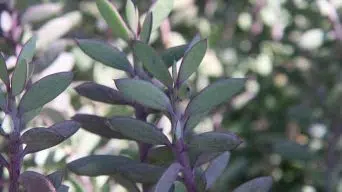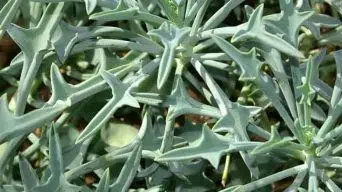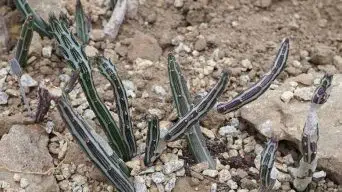Are you looking for a fun, low-maintenance plant to grow in your home? The Senecio Vitalis is a perfect choice!
This Senecio species can be grown indoors or outdoors and has some interesting features that make it stand out from other plants.
In this guide, we will cover everything there is to know about caring for this plant and propagating new ones so that you’ll have plenty of them around for years to come.
About the Senecio Vitalis Plant
The Senecio Vitalis plant, also known as Narrow Leaf Chalkstick or Blue Chalk Fingers, is a member of the daisy family (Asteraceae), including other plants such as the Erigeron and Helichrysum.
The Senecio Vitalis succulent grows up to 30 cm in height. It has dark green leaves that are often quite wavy on top and reach its yellowish-green flowering stage during late winter or early spring.
It originates in South Africa but can be found throughout many regions of southern Africa such as Namibia and Botswana, Cape Province (South Africa), KwaZulu Natal (South Africa), Zimbabwe, Namibia, and Botswana.
Senecio Vitalis succulents make for a great addition to any home.
These plants require little care and are easy to propagate, making them perfect for beginners and experts in the plant field.
Here’s how you can care for your Senecio Vitalis so it thrives.
How To Care for Senecio Vitalis
Sun Exposure & Light Requirements
The Senecio Vitalis succulent plant is a winter grower and does best in regions that receive some direct sun during the cool season.
The more sunlight it receives, the denser its leaves will be. It can also be grown as an indoor plant or on windowsills if you live in a region with mild winters.
A good rule of thumb for how much light your Senecio Vitalis needs is to give it at least four hours of bright indirect natural or artificial light per day.
Some people prefer six hours instead–that’s up to you! If your houseplant doesn’t seem happy with the amount of light it’s getting, try moving it to a brighter spot.
Watering Requirements
The Senecio Vitalis succulent plant should be watered a few times per week.
It prefers soil that is not too dry, but it will also survive if you forget to water it for two weeks in a row.
- Place the pot or container on pots of rocks so they have good drainage and can’t spill over while watering them.
- The soil needs to be moist enough without being soggy or wet. Use your finger as an indicator before planting any new plants. If the top inch of dirt has dried out, give it more water until it feels damp again.
- Never let moss grow inside containers because this creates stagnant conditions, which promote root rot and fungal growths like algae.
- When planting new plants, fill the pot with an inch or so of water to help settle the soil into place. Allow the excess to run out and let it drain for a few minutes before watering again.
- Keep in mind that this succulent plant will not survive if you overwater them as they are sensitive to too much moisture and don’t like wet feet.
Soil Requirements
The soil requirements for the Senecio Vitalis are similar to that of other succulents.
The plant should be mixed with sand, peat moss, and perlite with about one-third of water by volume.
This will result in an ideal drainage system for your plants while also holding moisture, which is important when caring for this succulent variety.
Switching up these ratios can help you meet high humidity or drought tolerance, depending on what’s needed most at the time!
Many people have had luck using regular potting soil with this succulent plant. It depends on how picky your plant is because they’re not all too particular about their soil type like some varieties might be.
Temperature and Humidity Requirements
The Senecio Vitalis succulent plant prefers a temperature of 20°C to 24 °C (68°F to 75 °F) and an average humidity level.
In the summer, keep your plant in a warm location with plenty of bright sunlight and good ventilation.
During the winter months, it’s best for this plant if you move the pot into a cooler area where there is less light, but make sure that frost does not happen when watering. It might be challenging to achieve both goals at the same time.
Carefully look at how much water they are getting each day or week, depending on what period you are dealing with while keeping them in their current location.
The Senecio Vitalis is a plant that prefers cool bright conditions with plenty of air circulation.
They need to be kept dry, so they like it best when the potting medium retains some moisture but isn’t constantly soaking wet. It needs good drainage and can grow in full sun or partial shade.
In frost-free regions, this succulent thrives outdoors all year long. In colder climates, you should keep it inside during the winter months when temperatures are more moderate (between 15°C – 20°C).
If it is hot during the day and cold at night, you should water at night instead of during the day. If there is a lot of humidity, then water droplets will stay on leaves for too long, which will cause them to burn.
Fertilizing Senecio Vitalis
The Senecio Vitalis succulent plant does not need much fertilizing.
You only need to fertilize the plant when it is in a resting phase, which should be during winter.
The best type of fertilizer for Senecios Vitalis plants is nitrogen-based and water-soluble such as ammonium nitrate or calcium nitrates.
You can also feed the plant by adding diluted liquid fertilizers every few weeks throughout the spring and summer months.
You will not want to add too much water or other liquid to your succulent because this could cause a plant disease called “nutrient burn.” It can damage the leaves, roots, and stems and kill the entire plant.
You may occasionally see yellowing on some of your older leaves; however, this is just natural senescence. This means the plant’s old leaves are dying, but new ones will grow.
Potting and Repotting
Potting and repotting are the best ways to grow Senecio Vitalis.
If you’re potting, make sure that your container has drainage holes because they require a lot of water. This is also useful for when it rains, so all the extra moisture can escape from the bottom (this will help keep it from rotting).
If you’re repotting, make sure to use a pot with drainage holes and sandy soil that has good drainage. This will help the roots stay healthy.
You should know that when it comes time for repotting or transplanting your Senecio Vitalis plant, they need at least three months of growth before you do so.
They are also weakened by moving their root mass too much and shouldn’t be moved more than once every two years.
When the Senecio Vitalis plant gets too large for its current pot, you can transplant it into a new container. The best time to do this is during the growing season when they’re actively putting outgrowth and are in good condition.
You should use moist soil that has been mixed with organic material such as compost or peat moss. This will help retain moisture in their root system while also providing nutrients that might not be present in regular potting mediums.
When planting your Senecio Vitalis succulent plants outside of pots, make sure to put them into a shallow hole so only about half of the roots stick out from the ground level.
It would be best if you watered frequently to help them establish their root systems and give a little bit of fertilizer about once every two weeks.
Pruning
The Senecio Vitalis succulent plant will need to be periodically pruned.
This will remove any dead or dying leaves and stems. This also prevents the plants from becoming unruly and spreading out of control.
To keep your Senecio Vitalis succulent looking its best, you will need to remove any dead or dying flowers and cut out damaged areas of the stem that are not firmly attached.
Dead flower stalks can remain until they turn brown. But then you’ll want to discard them away from where other plants grow as this could attract pests such as ants.
Cut off unsightly branches and ensure each branch is at least three inches long so that new roots can easily form.
When removing a limb from an established plant, it is best to make a clean cut just above where the limb meets the main stem.
The best time to prune is during the plant’s dormant period after it has gone totally dormant. Pruning should be done in late winter when there are no leaves or new growth on the stems.
Pests and Diseases
The Senecio Vitalis is not prone to pests or diseases. However, there are certain things you should watch out for:
- Spider mites and mealybugs may infest the leaves of this plant if those areas have been damaged by intense sunlight or high temperatures. This can be treated with an insecticide in most cases.
- Scale insects will occasionally attack this succulent plant. Still, they are only problematic when it becomes crowded inside a pot where these pests multiply rapidly. Scale has little effect on the overall health of the plants, so simply remove them from your pots after treatment with bleach water.
- Fungal infections that occur because of excessive moisture levels could cause brown spots to appear on some leaves, sometimes resulting in leaf drop.
- Senecio Vitalis are susceptible to bacterial leaf spot and rust, which can be treated with antibiotics if the infection is severe enough.
How To Propagate Senecio Vitalis Succulents
Cuttings
The easiest way to propagate Senecio Vitalis succulent is by cutting off a branch with at least three leaves.
- Ensure the stem’s cut side dries out before planting it in potting soil or other substrates.
- Place your propagated plant into an area with moderate light and water as needed, keeping humidity low if possible.
Seeds
You can also propagate Senecio Vitalis succulent by seed.
- Sprinkle the seeds onto a flat surface like a paper towel or window screen.
- Mist with water and cover the container until they sprout. Once they start to grow, keep in an area with low humidity and good light for optimal growth.
- Allow them to grow for two months before transplanting into a potting soil mix or other substrates.
Is the Senecio Vitalis Toxic?
No, the Senecio Vitalis is not toxic to animals or humans.
However, the Senecio Vitalis plant sap may irritate skin and eyes, so you must wash your hands after handling them.
This succulent does produce a milky latex which can be irritating if ingested.
Keep this succulent away from children and pets, as ingestion will irritate the mouth, throat, stomach, and intestines.
Final Thoughts
The Senecio Vitalis is a great plant to have in your home because it is very easy to care for and propagate.
You can use this succulent as an indoor or outdoor plant, which will do well in many environments.
You must be careful with the Senecio plant because they can become invasive and take over your garden.
It is not advised to plant them in a large area of bare ground but rather use it as an accent or interspersed among other plants.







